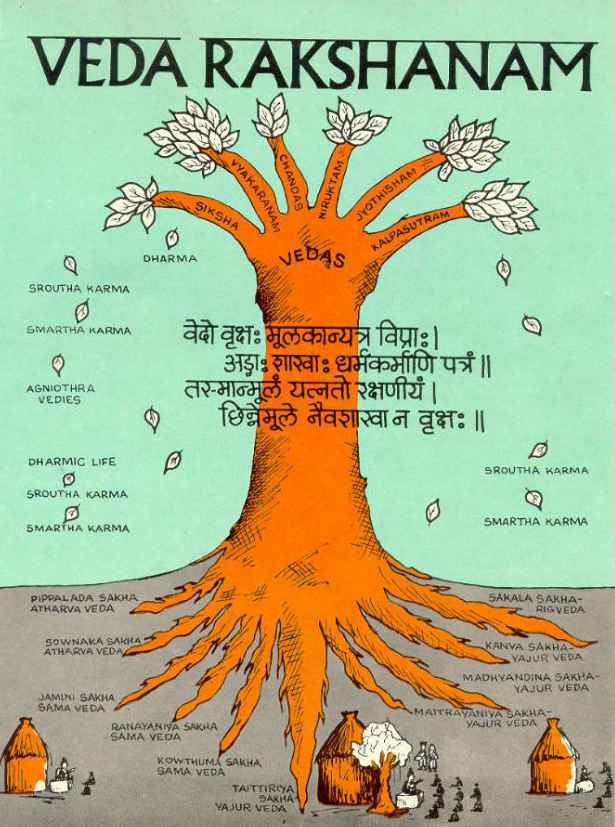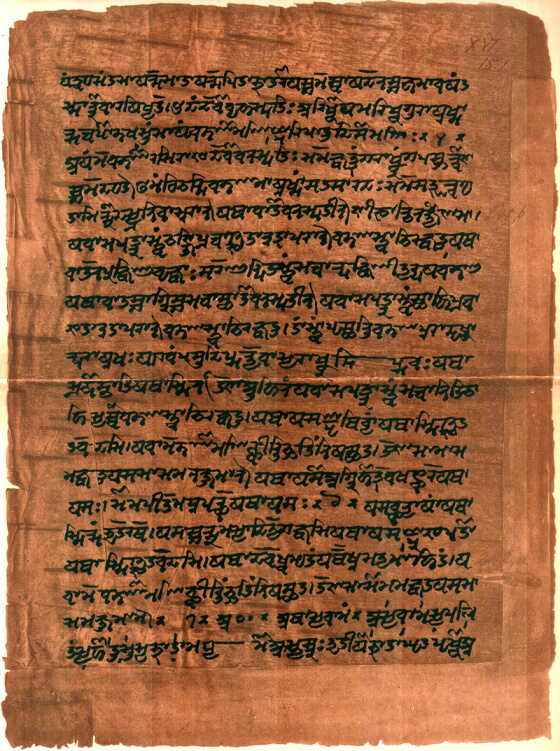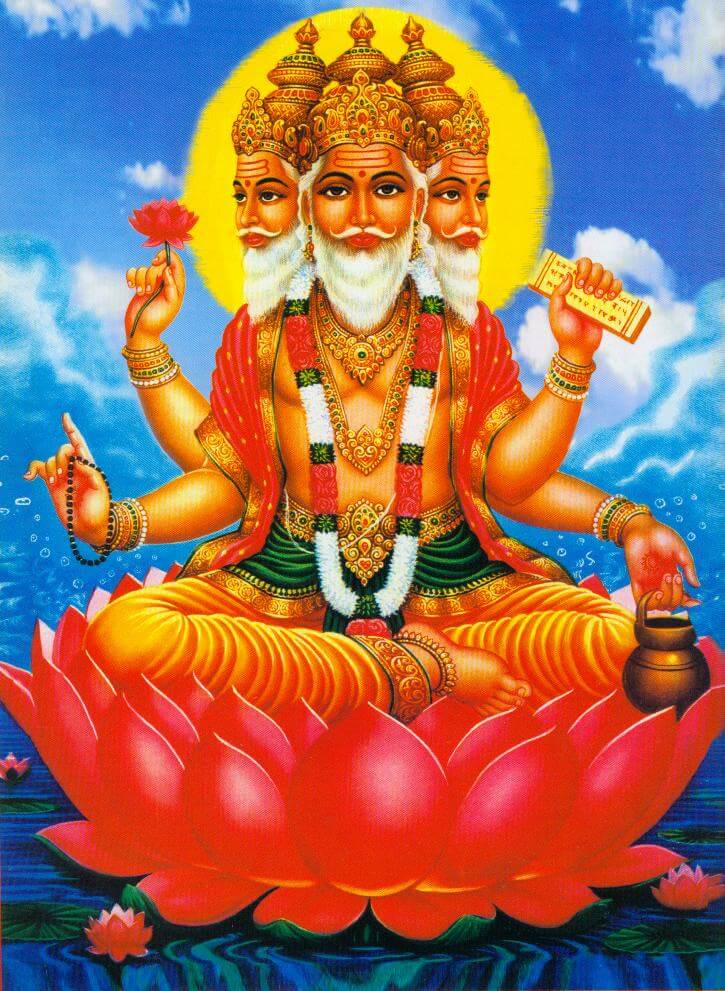Vedas
The Eternal Truths of the Universe!
Veda Vruksham
Veda is a like a tree, which is based on learned Vedia Bramins as its roots.
The six branches of Veda are:
1. Shiksha,
2. Vyakarana,
3. Chandas,
4. Niruktham,
5. Jyothisham and
6. Kalpam.
The various virtuous duties ordained in Vedas tantamount to its leaves.
If the roots are destroyed there will be no branches nor even the tree itself.
Therefore, the Vedic Bramins, the roots should be protected sparing no effort.
வேதம் ஒரு விருக்ஷம்
வேதம் ஒரு (மரம்) விருக்ஷம் என்றால், ஞானமுடைய வேதியர்கள் அதன் வேர்கள்.
வேதத்தின் அங்கங்களான சிக்க்ஷை, வியாகரணம், சந்தஸ், நிருக்தம், ஜ்யோதிஷம், கல்பம் முதலிய ஆறு அங்கங்கள், அதன் கிளைகள்.
வேதத்தில் விதிக்கப்பட்டுள்ள கடமைகள் அதன் இலைகள்.
வேர்கள் அழிக்கப்பட்டால் அதன் கிளைகள் மட்டுமல்ல, விருக்ஷமே இல்லாமல் போகும்.
ஆகவே எப்பாடு பட்டாயிகிலும் அதன் வேர்களாகிய வேதியர்கள் காக்கப்பட வேண்டும்.
The Vedas are the eternal truths revealed by God to the great ancient Rishis of India. The word Rishi means a Seer, from dris, to see. He is the Mantra-Drashta, seer of Mantra or thought. The thought was not his own. The Rishis saw the truths or heard them. Therefore, the Vedas are what are heard (Sruti). The Rishi did not write. He did not create it out of his mind. He was the seer of thought which existed already. He was only the spiritual discoverer of the thought. He is not the inventor of the Veda.
The Vedas represent the spiritual experiences of the Rishis of yore. The Rishi is only a medium or an agent to transmit to people the intuitional experiences which he received. The truths of the Vedas are revelations. All the other religions of the world claim their authority as being delivered by special messengers of God to certain persons, but the Vedas do not owe their authority to any one. They are themselves the authority as they are eternal, as they are the Knowledge of the Lord.
Lord Brahma, the Creator, imparted the divine knowledge to the Rishis or Seers. The Rishis disseminated the knowledge. The Vedic Rishis were great realised persons who had direct intuitive perception of Brahman or the Truth. They were inspired writers. They built a simple, grand and perfect system of religion and philosophy from which the founders and teachers of all other religions have drawn their inspiration.
The Vedas are the oldest books in the library of man. The truths contained in all religions are derived from the Vedas and are ultimately traceable to the Vedas. The Vedas are the fountain-head of religion. The Vedas are the ultimate source to which all religious knowledge can be traced. Religion is of divine origin. It was revealed by God to man in the earliest times. It is embodied in the Vedas.
The Vedas are eternal. They are without beginning and end. An ignorant man, may say how a book can be without beginning or end. By the Vedas, no books are meant. Vedas came out of the breath of the Lord. They are not the composition of any human mind. They were never written, never created. They are eternal and impersonal. The date of the Vedas has never been fixed. It can never be fixed. Vedas are eternal spiritual truths. Vedas are an embodiment of divine knowledge. The books may be destroyed, but the knowledge cannot be destroyed. Knowledge is eternal. In that sense, the Vedas are eternal.
The Yajurveda is different from the other Vedas in that it may be said to be divided into two Vedas which are considerably different from one another: the Sukla-Yajurveda and the Krsna-Yajurveda. “Sukla” means white, while “Krsna” means black. The Samhita of the Sukls-Yajurveda is also called “Vajasaneyi Samhita”. “Vajasaneyi” is one of the names of the sun god. It was the sun god who taught this Samhita to the sage Yajnavalkya.
In the Krsna-Yajurveda, the Samhita and the brahmanas do not form entirely different parts. The Brahmanas are appended here and there to the mantras of the Samhita Vedãs are the basis of the Sanathan Dharma. It is basis for existence of all ‘lokãs’; including the ‘Bhu-lokãa where we all reside.
It is also the duty (‘Rinam’ – debt) of the Brahmin for having born thus that he has the duty to learn, practice and propagate Vedãs.
This has been carried out for time immemorial – from the ages of the Rishis even to this day. Traditionally our fore-fathers had done niyama-adhyayana, carried out vocation and have successfully reared their families to the appropriate living standards at that time.
Due to various compulsions of time, like regular foreign invasions, English rule and man-made blunders, the concept of Veda -Adhyayanam has declined steadily.
Very great tapasvis like our Shankaracharyas have had great fore-sight and have done long standing arrangements in establishment of institutions who encourage Veda–Adhyayanam and champion its related activities. Only because of such foresight, Vedas have got relevance and reverence to us even now.
Sri Chandresekara Bharathi Chandrasekarendra Saraswathi Veda Vidyalaya Trust (Regd.) Sri Chandrasekara Bharathi and Sri Chandrasekarendra Saraswathi Veda Vidalaya Trust, was established in May 2003. The Veda Patasala is located in a serene and sylvan atmosphere in Coimbatore at MAHAMANTRA GRUHAM, 3/148-2, Ayyasamy Garden Avenue, Perur chettipalayam, Coimbatore – 641 010. Diligent care has been taken to preserve an austere ambience.
It was started with the prime objective of preserving and propagating, BRAHMANA, SAMHITA i.e. MOOLA PAATA, PADA, KRAMA, JATA, GHANA and LAKSHANA with SHADANGAS (portions of Krishna yajur veda). At present, Sri Chandresekara Bharathi Chandrasekarendra Saraswathi Veda Vidyalaya Trust imparts Vedic education to 17 students under the guidance and stewardship of Brahmasri Jambunaatha Ghanapaatigal.
A GLIMPSE INTO THE VEDAS
Just as the root is the prime source of energy for all the parts of the tree, Vedas are the vital and vibrant nucleus for all the growth and sustenance of the universe.
Vedas are the divine breath of the Almighty and consequently are ageless. They are called ‘Apourusheya’ [not ‘Man-made’]. The sounds of the vedas are permanently existent in the universe. Even the Bible refers to it as, ‘ In the beginning was the Word, and the Word was with God, and the Word was God. ‘John 1:1 [The first verse in the opening chapter of the Gospel of John.] In fact, the word, ‘word’ should be interpreted as ‘sound’ and not just any word.
The entire cosmic creation began with sound: “By His utterance came the universe.” (Brihadaranyaka Upanishad 1.2.4). The Vedanta-sutras add that ultimate liberation comes from sound as well (anavrittih shabdat).
Mantras, or sacred sounds, are used to pierce through sensual, mental and intellectual levels of existence (all lower strata of consciousness) for the purpose of purification and spiritual enlightenment. “By sound vibration one becomes liberated” (Vedanta-sutra 4.22).
Our Rishis have, by their superhuman powers grasped those sounds and, out of boundless compassion on humanity presented them in the form of vedas.
The Vedic texts were, by tradition, transmitted orally. This was essential because the texts were accentuated or in other words the different words and letters therein were recited according to different accentuation, modulation and time duration of each syllable. Very elaborate mnemonic devices were developed to preserve the purity of the texts as well as their pronunciation with precision and perfection. As a result, all Vedic texts, till date, have been transmitted over several millennia with utmost fidelity, together with their impeccable accent and articulation.
Without resort to writing, our forefathers had devised many ways to prevent even a very small error to creep into the Vedas. The potency of the manthras is in the sound. The fullest benefit from the Vedic mantras can result only if no word is changed; no unauthorised upward or downward drift in the note occurs in the recitation. Also, any incorrect intonation will result in deleterious consequences. Hence the numerous safeguards are prescribed so that a flawless system is evolved. How much time it should take to utter each word is indicated by resort to the notation by “maatras”-the time it takes to pronounce a short vowel. How to regulate breathing so that the vibrations can occur at what part of the body to give birth to the pure word sound is also laid down in the Vedanga Seeksha. The Taitreeya Upanishad, for e.g., begins with Seeksha thus:
Seeksham Vyakyaa syaamah – Varna Swarah – Maatrabalam – Saama Santaanah
Seeksha deals with Varna, Swara, Maatra, Strength, Saama and Santaanah
A fool-proof method is to chant each mantra in various patterns and combinations known as Vaakya, Pada, Krama, Jata, Maala, Sikha, Rekha, Dhwaja, Danda, Ratha, Ghana, etc.
Any person familiar with computer networks and internet communication today knows that when data is sent from one computer to the other through a wired/wireless medium, the data is usually repeated many times (sometimes in particular combinations) to make sure that any loss/error that may occur during transmission can be detected and corrected in the transmission end.
Thousands of years ago, our ancestors had similarly devised many brilliant ways of preserving our Vedas and making sure that no error is possible in the oral transmission of Vedas. The “data” was stored then in the human brain (weighing merely 200 grams). The human mouths were used for transmission while ears for reception and sound was the medium. And this was done from generation to generation.
The Four Vedas And Their Sub Divisions:
The Veda is divided into four as under:
- The Rig-Vedam.
- The Yajur-Vedam.
- The Sama-Vedam.
- The Atharva-Vedam.
The Yajur-Vedam is again divided into two parts:
- The Sukla Yajur-Vedam.
- The Krishna Yajur-Vedam.
The Krishna or the Tattiriya is the older form and the Sukla or Vajasaneya is a later revelation to Sage Yajnavalkya from the Sun-God.
The rishi for Krishna Yajur Vedam is Vaisampayanar. It contains, as per Vishnu Puranam, 94 Shakas. Today we have only one Shaka in practice, called Thaithireeya shaka.
Sutrakarars: Apasthasmbar, Bhodayanar, Vaikanasar, Sathyashadar, Bharadvajar, Agnivesar.
Name of the manthra portion: Thaithireeya Samhithai.
Names of the Brahmana portion: Thaithireeya, Vallabhi, Sathyayani, Maithrayani.
Names of the Upanishads: Kata, Kaivalya, Svethaswatara, Thaithireeya, Maha Narayana.
Each Vedam consists of four parts:
- The Mantra-Samhitas or hymns.
- The Brahmanas or explanations of Mantras or rituals.
- The Aranyakas (philosophical interpretations of the rituals).
- The Upanishads (The essence or the knowledge portion of the Vedas).
The division of the Vedas into four parts is to suit the four stages in a manb s life.
The Mantra-Samhitas are hymns in praise of the Vedic God for attaining material prosperity here and happiness hereafter. They are metrical poems comprising of prayers, hymns and incantations addressed to various deities, both subjective and objective. The Mantra portion of the Vedas is useful for the Brahmacharins (celibate; one who belongs to the first of the four Asramas or orders of life; one who, after getting anointed with ‘Brahmopadesam’, lives in purity and studies the Vedam as a full time duty during the early stage of his life).
The Brahmana portion is a guide for people to perform sacrificial rites. They are prose explanations of the method of using the Mantras in the Yajna or the sacrifice. The Brahmana portion is suitable for the householder (Grihastha; one who belongs to the second of the four Asramas or orders of life.).
The Aranyakas are the forest books, the mystical sylvan texts which give philosophical interpretations of the Rituals. The Aranyakas are intended for the Vanaprasthas (he third stage of life prior to Sanyasa or renunciation of the mundane world.]
The Upanishads are the most important portion of the Vedas. The Upanishads contain the essence or the knowledge portion of the Vedas. The philosophy of the Upanishads is sacred, supreme, sublime and sacrosanct.. The Upanishads speak of the identity of the individual soul and the Supreme Soul (jeevatma and paramatma). They reveal the most subtle and deep spiritual truths. The Upanishads are guiding sources for understanding the ultimate purpose of life, realising which one can transcend the cycle of births and deaths. [At the fourth stage, one has to mentally eschew all material attachments, relinquish domestic activities to his progeny and contemplate on the truths enunciated in the Upanishads under a proper Guru.]
[Note: Although the division of the Vedas into four parts is to suit the four stages in a manb s life, the study of the four Vedas is done by Brahmacharins or celibate students at the early stage of their lives and the knowledge thus acquired serves them later as the basis of the goal of life through all the four stages. The studies of the Vedas continue throughout oneb s life. ( for Dharma, Artha, Kama & Moksha). Thus the knowledge of the Upanishads need not be and should not be relegated to the last stage of life.]
The subject matter of the whole Veda is divided into:
- Karma-Kanda
- Upasana-Kanda
- Jnana-Kanda.
The Karma-Kanda or Ritualistic Section deals with various sacrifices and rituals.
The Upasana-Kanda or Worship-Section deals with various kinds of worship or meditation.
The Jana-Kanda or Knowledge-Section deals with the highest knowledge of Nirguna Brahman. (Nirguna = without attributes or forms. Brahman = the Supreme Reality).
The Mantras and the Brahmanas constitute Karma-Kanda (rituals).
The Aranyakas constitute Upasana-Kanda (worship).
The Upanishads constitute Jnana-Kanda (knowledge).
Inasmuch as the vedas contain precepts and prescriptions essential for human life, it becomes imperative that they should be preserved, propagated and practised in their pristine format for the benefit of mankind for all time to come and with this noble purpose in mind, our Sanathana Dharma organised a system wherein a section of the society is entrusted with the sole responsibility of this vital task. Enlisting eligible young boys at their pristine age, coaching them in the recitation of the vedas, expounding the import of the recital, educating them in all aspects of proper living, engaging them in the right path for their own welfare as well as the society, is the full time occupation of the Veda Patashalas.
When we listen to a Ghanapaati reciting Vedas in Ghana form, we note that he repeats the in various ways back and forth and in different patterns. This would be pleasant to the ears and creates a sense of happiness within. It would seem that the natural grandeur of the Veda mantras is heightened, as it were. In fact, apart from the ethereal resonance of the sound it has been proved that the vibrations have the magical effect of interacting with our physical and mental system and curing diseases.
In this context, the pivotal role being played by the Veda Patashalas acquire significance.
***************************


